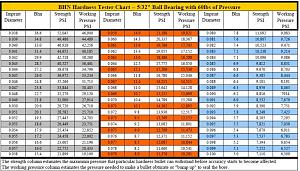If you know the ratio of your press linkage can't you hook up a fish scale to the handle and measure the weight that way?

|
   
   
|


|
If you know the ratio of your press linkage can't you hook up a fish scale to the handle and measure the weight that way?
The math didn't seem to work for me. Perhaps I did the math wrong. Here are my results using your formula:
-----------------Step one------Step two--------Step three----- Step four
Wheel Weights---0.06330------0.00401---------6.03467---------30.17334
Stick on-----------0.06700------0.00449-------- 5.38656---------26.93278
Range Scrap-----0.07000-------0.00490--------4.93474---------24.67372
Pure Lead--------0.15550------- 0.02418--------1.00000----------5.00000
Step one: First measure the indents in BOTH ingots with a Dial caliper.
Step two: Square the measurements.
Step three: Divide the unknown ingot SQUARE result into the Pure Lead SQUARE result.
Step four: Multiply by 5 and you now know the Brinell hardness opf the unknown ingot.
I found it interesting that my stick-on's and range scrap were much harder than I expected. I expected stick-on's in particular to be much softer after reading posts on this forum. I also did the "drop on floor, listen to the sound" test and was able to sort the ingots just by sound to the same order that I found in testing.
Cloudpeak
If you want to test toughness, check this link
Machinists do it with precision.
I tried Jbunny's method on post #9
I successfully measured a few different metal (of known hardness) by interpolation.
Instead of rectangular shape notching tip, I ground mine in a sort of elongated hexagonal that look like < >
So I can measure the tip of the notch easier.
I use a digital caliper to measure the width of the notch.
Starting measurements:
Pure Lead ingot (BHN 5) measured to be 3.02 mm wide
Lyman No 2 mixture ingot (previously measured BHN 15) measures 1.97 mm wide
So with the above result, I deduct that each notch width reduction of 0.1mm is corresponding to about 1 BHN increase in hardness.
How is that for a convenient coincidence?
Now, I get a piece of clip on WW, notched it and measure the notch to be 2.32mm (0.7mm less than lead)
thus the hardness of the WW is approximately 12 BHN - which is about right .
I also get an ingot of clip on WW that I made up a few weeks ago, it measures the same as the raw WW at BHN 12
Next I got a piece of 20 - 1 ingot I bought a while ago.
The tool made a notch of 2.53 mm which corresponding to about 10 BHN
Thus from the experiments conducted, I deduce that this tool actually works!
At least it works for materials between 5 and 15 BHN.
Made this hardness tester with a 60lb gas strut from Amazon. A pair go for $15. I compared results with a pencil hardness test and they came out pretty close to one another. Seems to work best if left under pressure for a while. One of the other posts mentioned 30 seconds and that seemed to produce good results for me also. This one uses a 5/32 ball bearing also from Amazon.

I've got a few extra air cylinders in the cabinet with 3/4 and 1" piston diameters. Should be pretty easy to fab up a fixture and figure out the pressure needed to give 60lbs on the rod end. I can compare to my LEE kit. I'm not too concerned with exact BHN, more how my different alloys compare and what the junk I bring home can be used for.
Does no one use the drawing pencils? Doesn't get much easier and quicker.
Take a kid to the range, you'll both be glad you did.
| BP | Bronze Point | IMR | Improved Military Rifle | PTD | Pointed |
| BR | Bench Rest | M | Magnum | RN | Round Nose |
| BT | Boat Tail | PL | Power-Lokt | SP | Soft Point |
| C | Compressed Charge | PR | Primer | SPCL | Soft Point "Core-Lokt" |
| HP | Hollow Point | PSPCL | Pointed Soft Point "Core Lokt" | C.O.L. | Cartridge Overall Length |
| PSP | Pointed Soft Point | Spz | Spitzer Point | SBT | Spitzer Boat Tail |
| LRN | Lead Round Nose | LWC | Lead Wad Cutter | LSWC | Lead Semi Wad Cutter |
| GC | Gas Check |